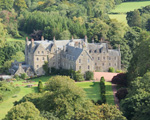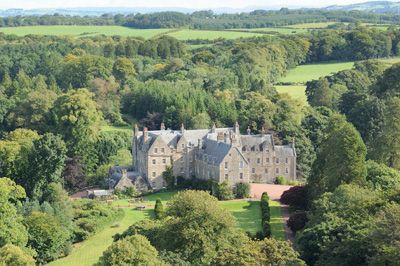For sale: One of Scotland’s greatest country houses
The ancestral home of the Blair family for over 900 years, Blair Castle is one of the most important houses in Scotland


This week sees the launch in Country Life of one of Scotland's great country houses, the Category A-listed Blair Castle and its 1,265-acre estate at Dalry, Ayrshire, ancestral home of the Blair family for more than 900 years. Savills in Edinburgh (0131-247 3720) seek ‘offers over £8 million' for the ‘wonderfully private but accessible' Lowland estate, with its unique landscape of 260 acres of park and woodland, 1,000 acres of farmland, four farmhouses and seven cottages, close to the Ayrshire coast, yet a mere 25 miles from Glasgow city centre.
It's hard to overstate the importance of the sale, for not only can the castle (not to be confused with Blair Castle in Perthshire) claim to be Scotland's oldest continually inhabited mansion house lived in by the same family-and never rebuilt or previously sold-but the bulk of its historic contents are also being offered by separate negotiation.
The feisty Blair family can trace its ancestry to 1165, when William the Lion awarded the Barony of Blair ‘for services rendered' to one Jean Francois, whose son William changed the family name to Blair. William was succeeded by Sir Bryce de Blair, who fought with William Wallace and Robert the Bruce, and was captured and executed by the English in 1296. Bryce was succeeded by Sir David de Blair, whose son Roger was knighted by Robert the Bruce at Bannockburn in 1314.

Roger married Marie Muir, the sister of David II, and their joint coat of arms can be seen above the door of the old tower, which dates from 1105. It was the first of two early Norman towers that form the basis of the present castle, and was built on three levels on the site of an ancient Celtic village in what is now the park. Although little is known of the ‘ancient castell and strong dounion' recorded by Timothy Pont in the late 16th century, the original Norman towers, extended in the 14th and 16th centuries, were later incorporated into major additions made to the castle by prominent family members in 1668, 1730 and the late 1800s.
The first of these, the 1668 south wing, was added by William Blair and his wife, Lady Margaret, whom he married in 1666. The couple had their initials carved above the windows of the castle to celebrate the conversion of a fairly rudimentary tower complex into a grand country house with beautifully proportioned rooms and fine plasterwork.
The east wing was built on in 1730, but without the top level, which was added as part of a series of extensive additions and adaptations carried out in the 1800s by William Fordyce Blair and his son Frederick, which effectively doubled the size of the house. The addition of the west wing to accommodate the bedrooms, bathrooms, servants' quarters, kitchens and service areas was probably made in successive phases.
William Fordyce Blair was a highly successful captain in Queen Victoria's navy, who served in the Anglo-Burmese War and was involved in the taking of Algiers in 1830. A highlight of his career was the capture of a pirate ship, which presumably helped to fund the improvements at Blair. He had the kitchen moved from the barrel-vaulted 1668 room to form what became his study. The 1668 drawing room, with its beautiful, Adam-style plasterwork, was originally two rooms, so Capt Blair created the present double-cubed room with Doric columns and a concealed beam to support the ceiling.
Sign up for the Country Life Newsletter
Exquisite houses, the beauty of Nature, and how to get the most from your life, straight to your inbox.
The splendid plaster ceiling was added in the mid-1800s using the heraldic motifs of the Hamilton and Blair crest. He was also a great collector of antiquities, and Blair Castle's notable collection of furniture, china, ironwork and artefacts-among them the delightful 18th-century Italian gates leading to the walled garden-are largely attributable to him.
The final work to the house was completed by Col Frederick Gordon Blair and his wife, Mary Baird, in 1893. Their only child, Cecily, was the last of the direct Blair line. Having lost her fiancé, Lord Robert Balfour of Birley, at the start of the First World War, Cecily inherited the Blair estate in 1943, but never married, moving to the east wing in her eighties, and dying there in 1978, aged 94.
Her bedroom in the former children's day nursery boasts a magnificent Chippendale bed bought for £30. In the meantime, Cecily transferred ownership of Blair to her nephew Michael Borwick, who, together with his wife, Veronica, set about renovating the estate. But tragedy struck once more, and following the death of his sons Freddie and Jamie in a car accident in 1969, Mr Borwick understandably lost interest in the restoration programme.
At that point, Luke Borwick, Michael's nephew, then aged only 21, agreed to take on responsibility for the estate, but apart from visits to Blair for family holidays, it wasn't until he and his wife, Caroline, were in their forties that they finally moved to Scotland, by which time their own children, Alexandra and Malcolm, were already grown up. With Luke's widowed aunt, Veronica, still living in the castle, he and Caroline converted the early Victorian carriage house, stables and dairy to a stylish, four-bedroom family house, which is still their main base.
In 2001, they embarked on the long and arduous task of rescuing the castle from decades of neglect, an energy-sapping enterprise that took some five years to complete. The results were dramatic: by 2008, Blair Castle, with its five reception rooms, 14 bedrooms and 13 bathrooms-plus four further bedrooms and three bathrooms in the east wing-was operating as one of a handful of Five-Star Exclusive Use venues for private and corporate hospitality recognised by the Scottish Tourist Board. The Borwicks have also revived Blair's spectacular gardens, the layout of which dates mainly from the mid 19th and early 20th centuries, although records of gardens exist as far back as the early 17th century.
The decision to sell this unique estate has been an agonising one for Mr and Mrs Borwick, but, faced with the prospect of running the business for another 20 years before their own child-ren could consider taking it on, they have decided to bow out in style, and leave it to someone else to create their own legacy at Blair. Theirs will be a seriously hard act to follow.
Country Life is unlike any other magazine: the only glossy weekly on the newsstand and the only magazine that has been guest-edited by HRH The King not once, but twice. It is a celebration of modern rural life and all its diverse joys and pleasures — that was first published in Queen Victoria's Diamond Jubilee year. Our eclectic mixture of witty and informative content — from the most up-to-date property news and commentary and a coveted glimpse inside some of the UK's best houses and gardens, to gardening, the arts and interior design, written by experts in their field — still cannot be found in print or online, anywhere else.
-
 'Monolithic, multi-layered and quite, quite magnificent. This was love at first bite': Tom Parker Bowles on his lifelong love affair with lasagne
'Monolithic, multi-layered and quite, quite magnificent. This was love at first bite': Tom Parker Bowles on his lifelong love affair with lasagneAn upwardly mobile spaghetti Bolognese, lasagne al forno, with oozing béchamel and layered meaty magnificence, is a bona fide comfort classic, declares Tom Parker Bowles.
By Tom Parker Bowles Published
-
 Country houses, cream teas and Baywatch: Country Life Quiz of the Day, April 24, 2025
Country houses, cream teas and Baywatch: Country Life Quiz of the Day, April 24, 2025Thursday's Quiz of the Day asks exactly how popular Baywatch became.
By Toby Keel Published
